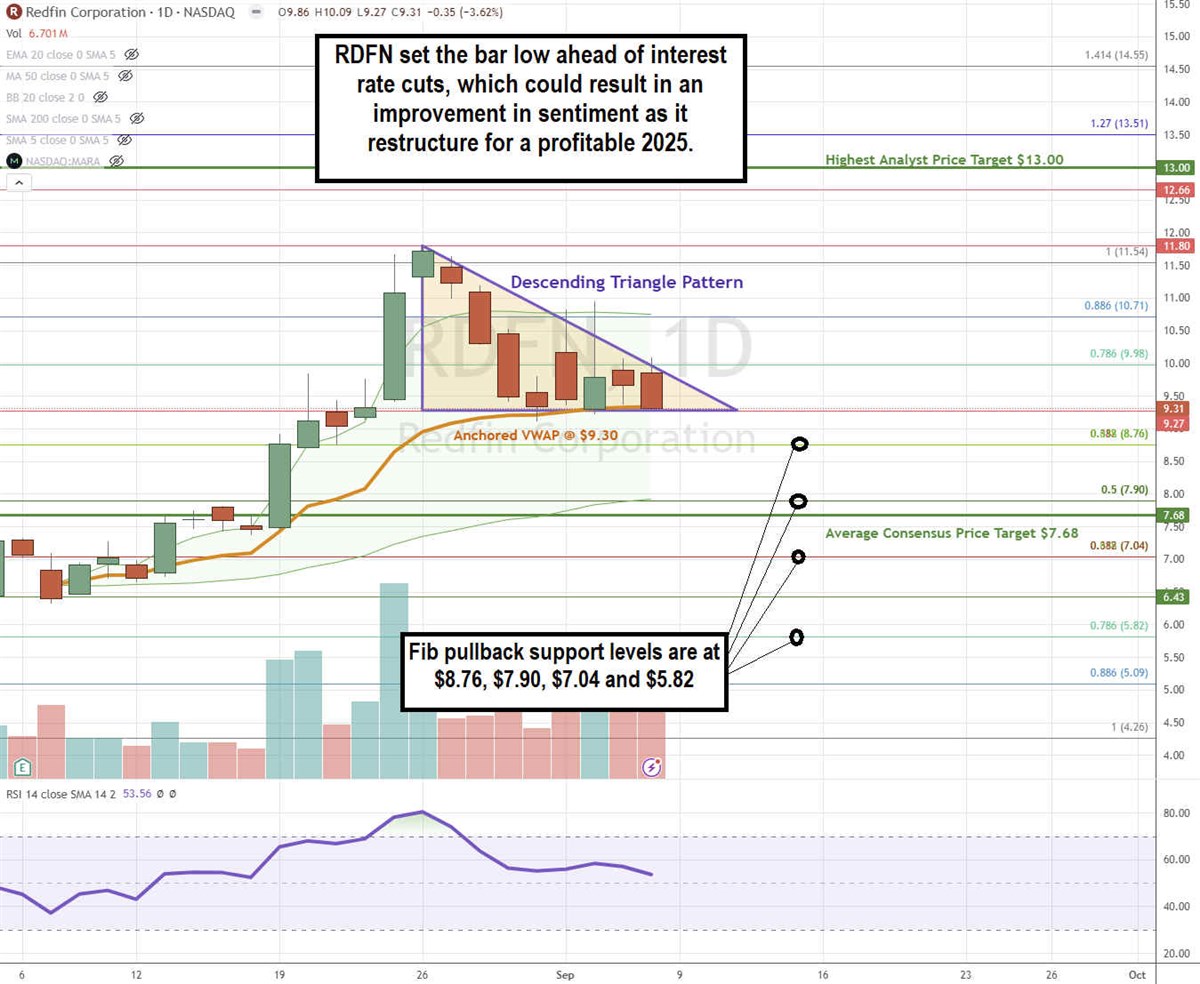
Residential real estate brokerage Redfin Co. (NASDAQ: RDFN) has been a disrupter in the finance sector, specifically in the residential real estate industry. The company has been losing money in the high interest rate and weak home-buying market.
Sentiment hasn't been great, as evidenced by its 15.44% short interest. However, with the U.S. Federal Reserve expected to start its interest rate cut cycle in September, things could improve for Redfin. Lower interest rates are expected to bring down home financing costs and help spur a rally in the housing market, improving the macroeconomic backdrop for borrowers.
How Redfin Disrupted the Residential Real Estate Business
Redfin is widely considered a disruptor in the real estate industry. Here are some of the ways they disrupted residential home-buying and selling.
- Technology Platform: Redfin introduced a technology-driven platform that empowered buyers and sellers with tools and access previously only available to licensed agents. The platform was one of the first to introduce interactive maps displaying homes for sale in neighborhoods along with pictures, descriptions, and even 360-degree video. The platform also provided data-driven insights to buyers and sellers, enabling them to navigate the market better and make more informed decisions.
- Lower Fees: Redfin tilted the playing field against real estate agents by challenging the long-standing legacy commission structure. Redfin offered lower listing fees, around 1% to 1.5%, versus 3% charged by real estate agents. This won over lots of sellers due to the reduced costs. Like Robinhood Markets Inc. (NASDAQ: HOOD) forced the online brokers to embrace zero-commission trading or risk being left behind, Redfin also caused real estate brokers to cut their fees.
- Do-It-Yourself Model: Redfin enables homeowners to sell or buy their homes without an agent, resulting in material savings. It also enables listings for home rentals by owners or agents.
- RedfinNow Home Buying Service: Redfin introduced a cash offer home buying service where they would make cash offers on homes and acquire them directly from sellers. They would renovate and resell them. Services like Zillow also did the same thing. Unfortunately, soaring interest rates and falling prices caused them to take huge losses and cease the service. Redfin enables owners to post their rentals for free, giving them access to 20 million visitors through its Rent platform.
- Customer-Centric Approach: While all real estate brokers claim to be customer-centric, Redfin prioritizes customer satisfaction, encouraging reviews and ratings to back this up. They wanted to make the house-buying process less pressured and more transparent, the opposite of the experience with traditional agents. This includes having salaried real estate agents and Redfin Next service rather than solely commission-based, emphasizing customer satisfaction. Redfin also provides ancillary services, including title and settlement services, financing options, and finding grants, credits, and assistance programs for homebuyers.
Redfin Lowers Q3 Guidance After Mixed Q2 Results
While Redfin has been a disruptor, the company hasn't been faring well in a higher interest rate environment. Redfin reported a Q2 2024 EPS loss of 23 cents, which was 3 cents better than consensus analyst estimates. Revenues still managed to rise 7.2% year-over-year (YoY) to $295.2 million, beating the $291.59 million consensus estimates. Redfin's mobile apps and website reached nearly 52 million average monthly users (MAUs). Redfin achieved a 28% mortgage attach rate, up four points.
Redfin lowered its third-quarter 2024 revenue guidance to $273 million to $285 million versus $295.77 million consensus estimates. Revenue estimates included components consisting of real estate services revenue of $171 million to $179 million, rentals revenue between $50 million and $51 million, mortgage revenue of $36 million to $39 million, and other revenue between $15 million and $16 million. Revenue growth is expected to be between 1% and 6% YoY. Total net loss is expected to be between $30 million and $22 million, more than the $19 million lost in the year-ago period. Adjusted EBITDA is expected to be around $4 million to $12 million, again falling short of consensus estimates, which are at $14.8 million.
Redfin Faces Market Decline but Prepares for Future Growth
Redfin CEO Glenn Kelman didn't sugarcoat expectations, confirming the housing market was still declining. He noted that the company is restructuring its brokerage sales force and integrating Rent and Redfin operations to increase the company's profitability eventually. He's already seeing results during the first half of 2024, existing U.S. Home sales fell 3%, but Redfin revenues rose 6%. Adjusted EBITDA will break even in 2024.
Kelman stated, “As our restructuring drives more rental traffic and better brokerage service, we expect revenue growth to accelerate, with most of that growth falling to the bottom line. When the housing market starts to recover, we'll do even better.”
Redfin operates in the finance sector, competing with Zillow Group Inc. (NASDAQ: ZG), Compass Inc. (NYSE: COMP), and RE/MAX Holdings Inc. (NYSE: RMAX).
RDFN Forms a Descending Triangle Pattern
A descending triangle is a bearish pattern formed by a descending (falling) upper trendline resistance that converges with a lower trendline comprised of flat-bottom horizontal support at the apex.

RDFN formed its descending upper trendline at the $11.80 swing high, converging with the $9.27 flat-bottom lower trendline support. The daily anchored VWAP support overlaps at $9.30 as they try to hold up the shares. The daily relative strength index (RSI) continues to fall slowly to the 53-band. Fibonacci (Fib) pullback support levels are at $8.76, $7.04, $5.82, and $5.09.
Redfin’s average consensus price target is $7.68, and its highest analyst price target sits at $13.00. On Sept.3, 2024, B.Riley Securities raised its rating to a Buy from Neutral and raised its price target to $13.00.
Actionable Options Strategies: RDFN is trading above its average consensus price target. Seasoned options traders can consider using cash-secured puts under the Fib support pullback levels to buy on a pullback. Upside targets include the fib extensions. A wheel strategy can be executed by writing covered calls after being assigned.





